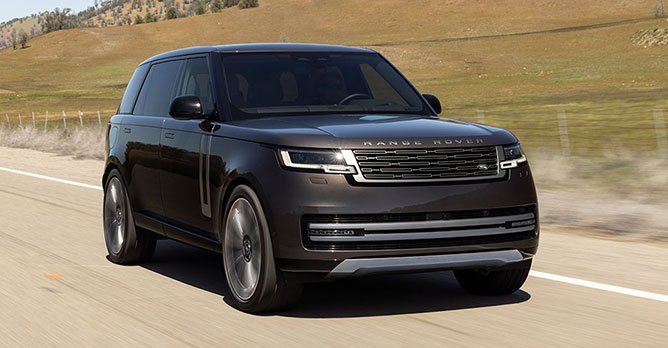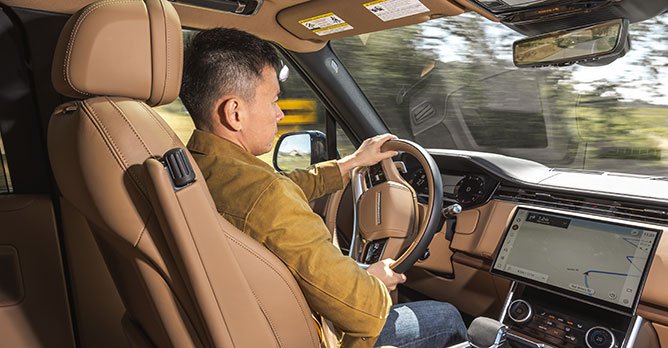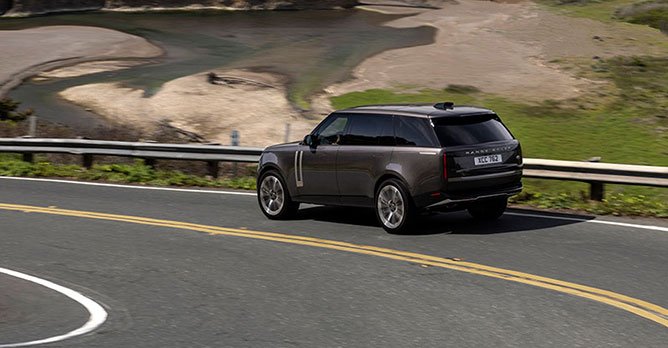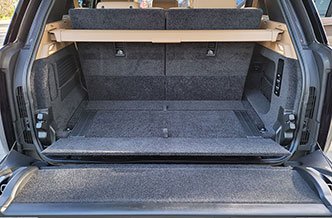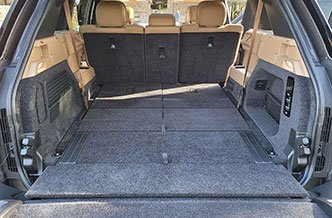Land Rover Range Rover 3.0 7-seater (A) First Drive Review
19 Apr 2022|4,583 views
What We Like
There's an option for a seven-seater configuration
It's lighter on its feet, which makes it more agile and flexible around corners
Still feels quick off the line
It's just as luxurious and comfortable as the V8 brethren
What We Dislike
Doesn't sound as addictive as the V8 variant
Being fast does not equate to being fun. I've said that many times for many years and it still stands true today. Only problem is, I think such a brilliant remark that's filled with so much wisdom and experience does not quite fit the bill with the Range Rover flagship SUV that you see here on this very page.
You see, having a bigger and juicier 4.4-litre V8 twin-turbo definitely makes the Range Rover more entertaining and dramatic on the road. On the other hand, a 3.0-litre in-line six would suffice, but it somehow lacks the oomph that's needed to make the 2.6-tonne SUV more excitable. Both of them, however, aren't what you call a 'fun' car - and that's regardless of what sort of engine it's fitted with.
So bigger is better?
In this case, while the smaller 3.0-litre variant is the less exciting one of the two, it's certainly the more charming and accomplished SUV to drive. Not to mention, it'll also be cheaper to own, which makes it a rather sensible choice to consider when the Range Rover flagship SUV arrives in later this year in July.
So, unfortunately, while there is no replacement for displacement and size does matter in most situations, bigger isn't exactly better here. Don't get me wrong, the 4.4-litre V8 variant was a delight to pilot, easy on the eyes and pleasurable for the ears and I would have loved to drive this, and only this, throughout my entire time in San Francisco. But as work would have it, there were different variants of the car that I needed to drive, and I found the 3.0-litre variant here to be the more enchanting one.
Feet of a ballet dancer
For one, the car is light on its feet, with a front end that's more agile and flexible around corners. That's also because it's about 30kg lighter than the V8 and you feel it the moment you pilot it. Braking can be done later with little to no dive, acceleration out of corners is more contained and calm, and the Rangie still has ample speed to see you through to the exit of the corner.
It isn't going to set the tarmac on fire when you put pedal to the metal, but it's not by any means slow. The engine still manages to dispense a generous dose of 396bhp and 550Nm of torque, which helps it finish the century sprint in a respectable 6.1 seconds - just a second and a half slower than the V8 brethren.
Needless to say, I seriously doubt that there will be buyers of the Range Rover who will drive the car like I did, but it's always good to know that the car is capable of doing it even if you know you won't be.
And that's sort of like the whole off-roading exercise that I experienced with the car. While it isn't as hardcore as, say, a Land Rover Defender or a Land Rover Discovery, I can fully comprehend the whole logic behind allowing us to experience the off-roading portion. I mean, if I bought the Rangie, I sure as hell wouldn't be taking it off the tarmac. It'll probably be 'mounting the kerb and onto the grass' at best rather than steep, slippery slopes that are filled with rocks and sticks.
But knowing that the car is actually more than capable of handling itself off the road, and then some, makes it such an endearing trait. Just like how well it can hold itself around corners, knowing how capable it really is off the roads makes this Rangie such a charming box on wheels, even if you know you'll never explore any jungle with it.
The one to have
The Range Rover, whichever variant you decide to get barring the highly-customisable SV, looks remarkably brilliant and bright, with a very clean and modern surface that hasn't lost its iconic look. The rear of the car obviously takes the cake. It's very current and minimalistic, considering how the brake lights and indicators are all hidden behind the black panel until they are activated.
In other words, the engine (which will be cheaper to maintain) and the way it drives (which is nimbler) are the only key differences this 3.0-litre variant has over the 4.4-litre sibling. And those are the sort of traits you'll need to take note of if you're looking for longevity in a car ownership experience in Singapore. There… another brilliant remark that's filled with so much wisdom and experience.
Looking out for an extravagant SUV? Here are several options to consider:
The new X7 is BMW's everything car
Luxurious refinement in the Bentayga Diesel
The Rolls-Royce Cullinan has an impressive breadth of ability
What We Like
There's an option for a seven-seater configuration
It's lighter on its feet, which makes it more agile and flexible around corners
Still feels quick off the line
It's just as luxurious and comfortable as the V8 brethren
What We Dislike
Doesn't sound as addictive as the V8 variant
Being fast does not equate to being fun. I've said that many times for many years and it still stands true today. Only problem is, I think such a brilliant remark that's filled with so much wisdom and experience does not quite fit the bill with the Range Rover flagship SUV that you see here on this very page.
You see, having a bigger and juicier 4.4-litre V8 twin-turbo definitely makes the Range Rover more entertaining and dramatic on the road. On the other hand, a 3.0-litre in-line six would suffice, but it somehow lacks the oomph that's needed to make the 2.6-tonne SUV more excitable. Both of them, however, aren't what you call a 'fun' car - and that's regardless of what sort of engine it's fitted with.
So bigger is better?
In this case, while the smaller 3.0-litre variant is the less exciting one of the two, it's certainly the more charming and accomplished SUV to drive. Not to mention, it'll also be cheaper to own, which makes it a rather sensible choice to consider when the Range Rover flagship SUV arrives in later this year in July.
So, unfortunately, while there is no replacement for displacement and size does matter in most situations, bigger isn't exactly better here. Don't get me wrong, the 4.4-litre V8 variant was a delight to pilot, easy on the eyes and pleasurable for the ears and I would have loved to drive this, and only this, throughout my entire time in San Francisco. But as work would have it, there were different variants of the car that I needed to drive, and I found the 3.0-litre variant here to be the more enchanting one.
Feet of a ballet dancer
For one, the car is light on its feet, with a front end that's more agile and flexible around corners. That's also because it's about 30kg lighter than the V8 and you feel it the moment you pilot it. Braking can be done later with little to no dive, acceleration out of corners is more contained and calm, and the Rangie still has ample speed to see you through to the exit of the corner.
It isn't going to set the tarmac on fire when you put pedal to the metal, but it's not by any means slow. The engine still manages to dispense a generous dose of 396bhp and 550Nm of torque, which helps it finish the century sprint in a respectable 6.1 seconds - just a second and a half slower than the V8 brethren.
Needless to say, I seriously doubt that there will be buyers of the Range Rover who will drive the car like I did, but it's always good to know that the car is capable of doing it even if you know you won't be.
And that's sort of like the whole off-roading exercise that I experienced with the car. While it isn't as hardcore as, say, a Land Rover Defender or a Land Rover Discovery, I can fully comprehend the whole logic behind allowing us to experience the off-roading portion. I mean, if I bought the Rangie, I sure as hell wouldn't be taking it off the tarmac. It'll probably be 'mounting the kerb and onto the grass' at best rather than steep, slippery slopes that are filled with rocks and sticks.
But knowing that the car is actually more than capable of handling itself off the road, and then some, makes it such an endearing trait. Just like how well it can hold itself around corners, knowing how capable it really is off the roads makes this Rangie such a charming box on wheels, even if you know you'll never explore any jungle with it.
The one to have
The Range Rover, whichever variant you decide to get barring the highly-customisable SV, looks remarkably brilliant and bright, with a very clean and modern surface that hasn't lost its iconic look. The rear of the car obviously takes the cake. It's very current and minimalistic, considering how the brake lights and indicators are all hidden behind the black panel until they are activated.
In other words, the engine (which will be cheaper to maintain) and the way it drives (which is nimbler) are the only key differences this 3.0-litre variant has over the 4.4-litre sibling. And those are the sort of traits you'll need to take note of if you're looking for longevity in a car ownership experience in Singapore. There… another brilliant remark that's filled with so much wisdom and experience.
Looking out for an extravagant SUV? Here are several options to consider:
The new X7 is BMW's everything car
Luxurious refinement in the Bentayga Diesel
The Rolls-Royce Cullinan has an impressive breadth of ability
Thank You For Your Subscription.


























